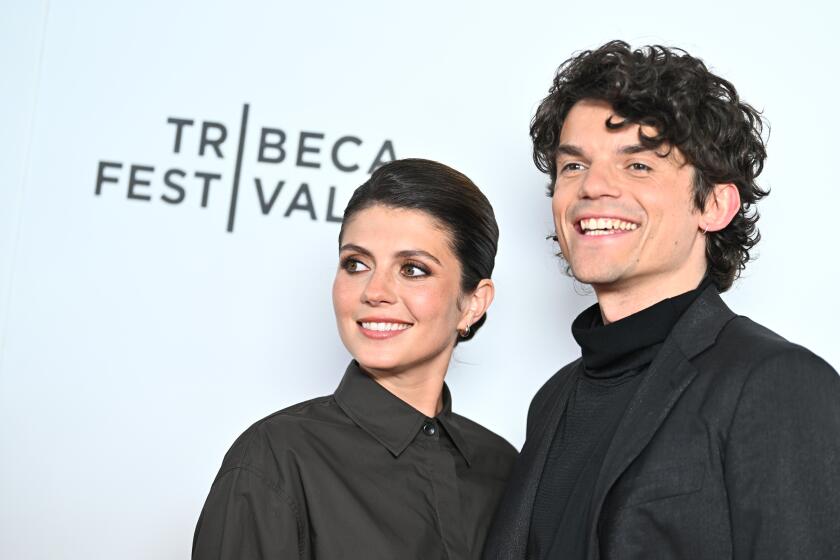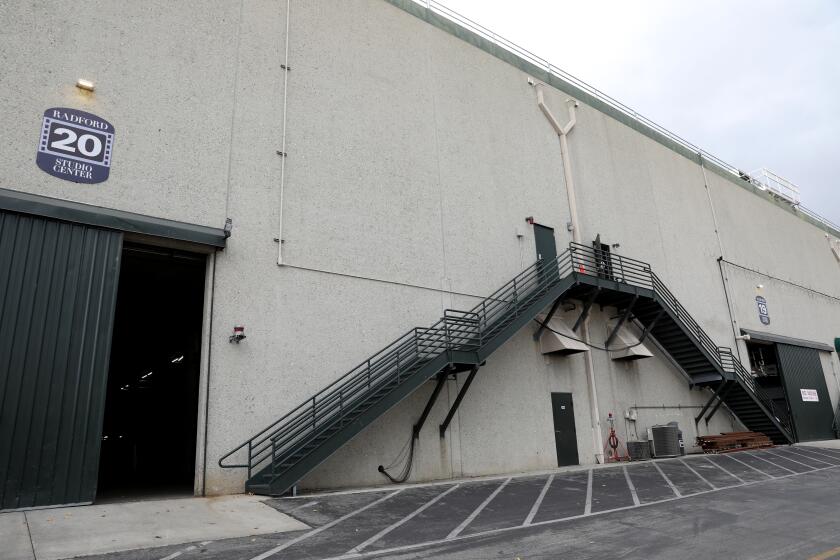Let’s put on a show -- fast
Gusts of nervous energy have been whipping through the Kodak Theatre this week.
With Sunday’s Oscar telecast just days away, host Jon Stewart and his team of “Daily Show” scribes hadn’t finished his comic bits. Tony Award winner Kristin Chenoweth was still hashing out the details of her Broadway-scale musical number -- the largest of several major productions.
Show director Louis J. Horvitz and his staff were breathlessly playing catch-up, working out the glitches that come with one of the most logistically complex sets of any Oscar ceremony.
And then there was Sunday’s weather forecast, a 30% chance of rain. Crews were hurriedly tenting the red carpet, an otherwise glamorous path stretching longer than a football field.
Backstage, half a dozen small, hand-written “Quiet please” signs had sprouted up overnight and were then replaced a day later by “QUIET PLEASE!” posters -- evidence that a stress threshold had been reached. This Oscar brain trust had been pulling double duty for weeks, thanks to the recent writers strike, because plans had to be made for two shows, one if the labor dispute was settled and one strike-proof.
Until 10 days ago, Hollywood was panicked by the possibility that the 80th annual Academy Awards would be nothing more than a sophisticated film package. But when the strike was lifted Feb. 13, producer Gilbert Cates told Stewart to catch a flight to L.A., and production kicked into high gear on the star-studded show everyone hoped to see.
Although it has been an especially bumpy ride to the Oscars this year, Cates and his team of veterans hope that all this last-minute running -- along with the extravagant musical numbers and the presence of young stars such as Miley Cyrus, Jessica Alba and Katherine Heigl -- will result in a show that beats ratings expectations and draws at least the same 40 million viewers that tuned in last year. Stewart, who is accustomed to news deadlines on his Comedy Central show, is convinced that all this freneticism can only help the telecast.
“There’s always got to be a certain sense of urgency with these types of shows,” he said, reviewing script changes in his office Wednesday. “It’s that way with our show, and we only have a day to do those. If you don’t have that urgency, it’s reflected in the emotional energy of the program. And also in the writing. And in the performance. You need that sense of -- not panic -- but it should be a controlled panic.”
--
Show almost wasn’t
The extravaganza that audiences will see Sunday night is the show that almost wasn’t. At one point, it looked as if the writers strike -- and the high-profile actors who would refuse to cross picket lines -- would force Cates and his team to go with his “Plan B” for the ceremony. Instead of swanning starlets and a tuxedoed George Clooney, viewers would have seen three-plus hours of film montages of old opening monologues and award-winning foreign films, among other subjects. Now only a fraction of that work will make this year’s broadcast. The rest goes into the vaults of the Academy of Motion Picture Arts and Sciences for future shows.
“There were times during the first two weeks of February I thought we were absolutely going to do the B show, when it was clearly not questioned at all,” said the producer.
Cates has maintained (publicly, anyway) an oddly Zen attitude about pulling this off while helping settle the recent contract talks between the studios and the Directors Guild of America. Many industry insiders considered his work the catalyst that revived negotiations between the Writers Guild of America and studio heads, ending the 14-week strike and saving the Oscar telecast from the fate of this year’s dead-in-the-water Golden Globes.
“He’s the hero on all of this,” said associate producer Michael Seligman, fielding calls in his backstage office.
Planning for the Academy Awards began as usual around Thanksgiving, when Cates and set designer Roy Christopher started creating the stage. It wasn’t until mid-January -- with the stage being built and talent wrangling underway -- that Cates and his staff realized they needed a Plan B. For the next few weeks, they put together two shows: one that allowed for celebrities and writers and one heavy on film packages and musical numbers.
At the same time, Cates would duck out to act as the chairman of the DGA’s negotiating committee, leading talks on behalf of 13,400 members. Somehow, he said, the two duties didn’t peak at the same time. “While I was doing negotiations, the set had already been designed and they were doing blueprints on it,” he said. “When negotiations stopped, then [Oscar planning] began to heat up.”
Behind the scenes at the Kodak this week, the countdown to Oscar night hadn’t yet prompted any meltdowns. Indeed, the most emotional outburst was the occasional “Ay, yi yi!” from Seligman. This remarkable restraint was thanks in large part to Cates’ unflappable and indomitably optimistic presence. When asked about the series of challenges he’s faced down in the last few months, the 73-year-old leaned back in his chair, popped Jelly Bellys into his mouth and quipped, “It’s just showbiz!”
Maybe it’s Cates’ weekly Pilates classes. Or maybe it’s because in his 13 times producing the Oscars, he has navigated his share of near-disasters -- in 1998, a technicians union threatened to black out the broadcast just as the best picture winner was announced, and in 2003 the U.S. invaded Iraq just hours before the ceremony.
To hear his longtime consultant Robert Z. Shapiro talk, Cates thrives on this sort of tension. “When things might go bad, he loves it,” Shapiro said. “He just loves turning stuff around. He’s very deft at handling all kinds of situations.”
--
Different pace
A few doors down from Cates’ office, Stewart said he and his writers had nearly finished his opening monologue.
“We’ve got everything but the adverbs,” he said.
In fact, Stewart was prepared to fine-tune his bits up to the very last minute -- as in, moments before he walks on stage. With his turn as host in 2006 having drawn mixed reviews, Stewart said he might pace himself differently this time. “I came out a little tentative, started owning the show a little later on when I was comfortable,” he said. “Maybe the lesson there is just come out and own it as early as you can. But you can own it and no one else thinks you do.”
In the theater, Horvitz and his crew were busy running through the entire show, testing camera angles, graphics and lights -- an aggressive attempt to find the glitches.
The biggest challenge, he said, was synchronizing the 20 workers as they maneuvered the stage’s centerpieces -- five 35-foot, 3,000-pound tubes suspended on stage that are raised and lowered by hand. “It’s like trying to choreograph water ballet,” said Horvitz. “It’s a tough one.”
For his part, Cates has repeatedly downplayed the pressure he and his team have been battling. But then he was reminded of something he said five years ago about the 2003 wartime show. That telecast was full of last-minute upheaval. Celebrity presenters withdrew at the last minute. The fan bleachers and the red carpet were pulled. Dozens of war protesters showed up. The show opening was scrapped because it made the Kodak look too much like a bomb target, and there was a good chance the show would be interrupted by ABC News’ Peter Jennings.
At the time, Cates called that telecast his toughest ever.
“I was wrong,” he said, pulling off his glasses and rubbing his eyes. “This was the most difficult show for everybody.”
--
More to Read
The biggest entertainment stories
Get our big stories about Hollywood, film, television, music, arts, culture and more right in your inbox as soon as they publish.
You may occasionally receive promotional content from the Los Angeles Times.






